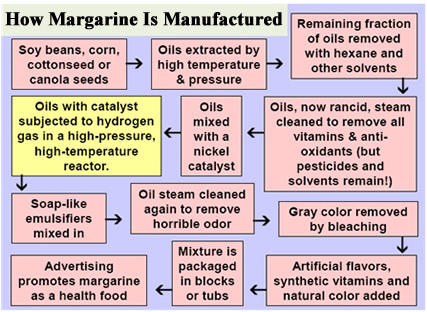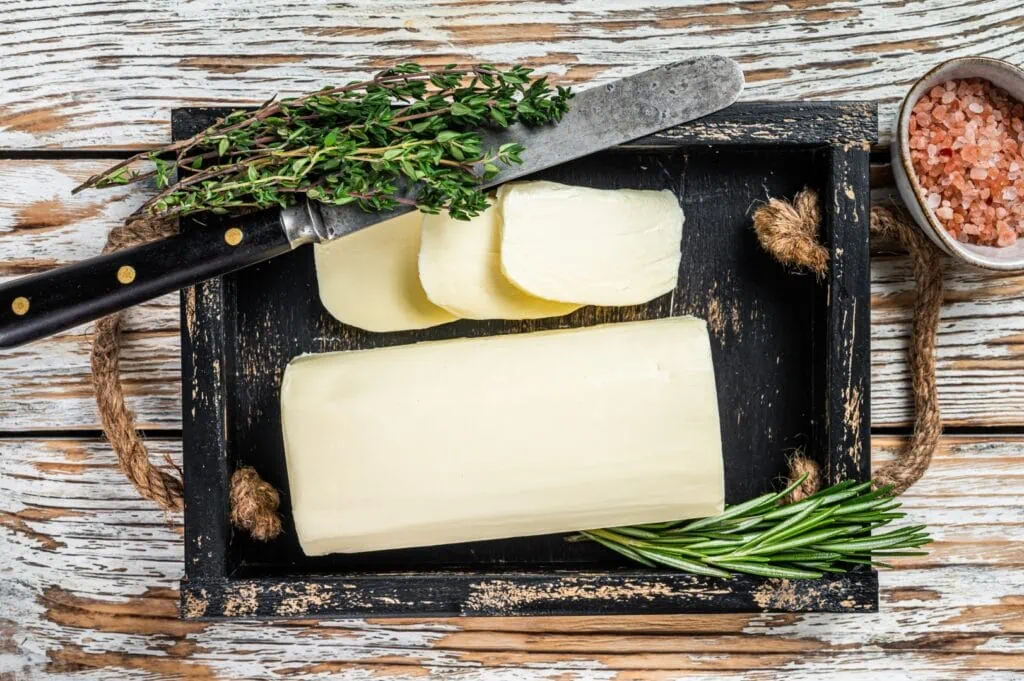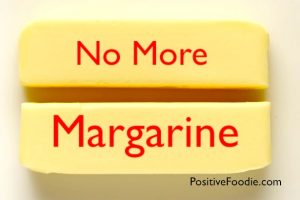As a child throughout the nineties, I can’t remember when we didn’t have margarine in the fridge. Never butter. TV, radio, and medical shows (I was a weird kid) all taught me exactly why that was too – Butter causes heart attacks, strokes, and all kinds of other things because fats are bad for you (even though – you know – our ancestors had done just fine for thousands of years) – so it was never something I bothered to question. Margarine has less harmful polyunsaturated fats in it they said which in turn will prevent disease.
Flash forward a few decades and we now know that that’s certainly not the case. In fact, the truth is quite the opposite – During the same period that butter consumption decreased, heart disease became a number one killer.
Of course, once I moved out on my own and tasted butter for the first time I never went back (which I’m really glad for). If you haven’t yet made the transition yourself, or if you have and you need a reminder as to why you don’t ever want to purchase margarine again, you’re definitely going to want to continue reading.
How Margarine Is Made
Most margarines are made with either vegetable or canola oil, right? So let’s start there – Vegetable oils are generally manufactured with GMO crops that have been heavily treated with pesticides and who knows what other chemicals. Funny enough though, that’s the least of your worries.
Canola oil is like the poster child for vegetable oil. Most restaurants use it, and if you have a deep fryer at home there’s a good chance that’s what’s in it. Canola oil is created using rapeseed (which contains high amounts of erucic acid). Canola oil was originally called LEAR (Low Erucic Acid Rapeseed) oil, but when that didn’t sell very well the name was changed. Marketing can be a pretty powerful thing.
But here’s the thing – Rapeseed oil is used to power engines.
That vegetable oil – regardless of where it originally comes from – needs to be processed NINE TIMES before it can be packages in tubs and sold as margarine. Here’s a handy chart showing how the process works:

Via healthimpactnews.com
Nine times! And is this synthetic chemical wasteland supposed to be good for us? After all that? No, thank you. Pass the butter.
How Butter Is Made
When a cow is milked, a heavy cream will rise off of it when it sits for a little while. That cream is taken and churned (or shaken) – with maybe a little bit of salt – until it turns into butter. That’s it. Cream. And sometimes salt.
Butter can be purchased in grocery stores, but I strongly suggest making your own. If you have a food processor, blender, or stand-up mixer, the process is slightly easier, but I go the old fashion route and use a jar. You can also opt for a whisk and bowl.
Some people may argue that it’s actually cheaper for them to buy butter than it is for them to make it. Whether that’s actually true is quite debatable – When you make your own butter, you’re actually getting two for the price of one: You get amazing, homemade butter (just make sure you use organic cream) as well as buttermilk (real buttermilk, not cultured homogenized ultra-pasteurized grossness). You’ll have to culture the butter yourself (naturally) if you want it to be able to keep on the counter for spreading, but it’s totally worth it.

Not all butter is created equally, though. If you insist on buying your butter from the grocery store, choose carefully.
Cows that have been pumped full of antibiotics their whole lives, fed nothing but GMO grains, and crammed together in inhabitable conditions since birth produce toxic milk (and, in turn, cream), which makes toxic butter full of growth hormones, antibiotics, pesticides, and other chemicals. As with everything else, organic is best (and I promise you it tastes better).
You Need To Avoid Margarine
It’s Full Of Trans Fats And Free Radicals
Trans fats are not natural. They form during the hydrogenation process. Trans fats are known contributors to heart disease, cancers, bone problems, hormonal imbalances, infertility (and a bunch of other pregnancy and post-delivery issues), and could even contribute to learning disabilities.
Free radicals (and other toxic breakdown products – another friendly result of the processing) have been known to contribute to cancers, heart disease, and other health problems as well.
Doused In Bleach
Partially hydrogenated vegetable oil isn’t the pretty cream colour of margarine. It’s grey. But no one wants to spread grey on their toast in the morning, so it needs to be bleached white, and then you need to add yellow food colouring to it. And since that grey stuff also tastes disgusting, you need to also add artificial flavour that doesn’t taste at all like butter in an effort to trick your mind. Tasty, right?
And Other Disgusting Things

All kinds of preservatives of questionable safety go into the making of vegetable oil (I told you that GMOs were the least of your problems this time), and many margarines are actually stabilized with BHT (a synthetic antioxidant). And as though there aren’t enough trans fats already, mono-glycerides and di-glycerides are added for good measure. Since these don’t have to be listed in the ingredients, they can be used in high amounts in a “low trans” spread.
Speaking of spreads, have you ever used one of those “spreadable” butter like substances (I remember them becoming popular maybe ten years ago now)? If so, you can bet your bottom dollar that it was laced In soy protein isolate – A very highly processed powder that gives “low trans” spreads body. Soy protein isolate is a contributor to thyroid issues and digestive problems (which we all know can be a huge contributor to weight gain. Aka when they said that margarine would help you lose weight, they were so very, very wrong).
And if you decide to ingest the cholesterol-lowering variety, you’re in for a real treat – It’s chalked full of estrogen compounds called sterols.
Some Vitamins In There For Good Measure
Real butter has Vitamin A – and many others – in it (Ghee is actually one of the best natural sources of the vitamin – Just one serving has 28% of our RDA). These vitamins are synthesized and added to the hydrogenated goop during the nine step process. Since they’re not real vitamins, they don’t have the same (or any, really) effect on your body as the natural ones found in butter do.
Switch To Butter Instead
Now that you know what disgustingness goes into making margarine, you might wonder how much better real butter can actually be. The answer is inexplicable! But I’m definitely going to try – Real, organic, grass fed butter (bought or made) has a TON of beneficial components. Here are just a few of them:
- Beta-carotene, selenium, and other antioxidants to help shield you from the damage your body takes from free radicals (how’s that for opposite ends of the spectrum?). Great for your skin, hair, nails, and eyes.
- Conjugated linoleic acids that not only help fight off cancers but can also help you build muscle and boost your immunity.
- Iodine, which is essential for optimal thyroid health.
- Lecithin, which helps to protect your cells from oxidation and, in turn, could help metabolize your cholesterol.
- Vitamins A, D, E, and K – The real kind. These vitamins play a roll in everything from eye to colon health and can even help prevent certain diseases (like Alzheimer’s).

Your body needs saturated fats and good cholesterol. Butter has both, and unless you’re planning to sit down and eat an entire tub with it at every meal, you shouldn’t have an issue.
Besides butter, you can and should definitely eat a variety of other saturated fats of both animal and plant origin (as always, make sure they come from organic sources). Moreover, don’t be afraid to use saturated fats for cooking – they are significantly more heat stable than any commonly used vegetable refined oils the market is full of.
Vegetable oils are in almost every processed and prepackaged food marketed today. Sometimes, it’s unavoidable (unless you’re super careful, and even then, there’s no guarantee), but margarine vs butter is not one of those instances. Hopefully, I’ve convinced you to make the switch if you haven’t already (I’ve certainly reconvinced myself to never even think about buying it ever again regardless of how on sale it is – You know the inner debate, I’m sure you’ve had it yourself at least once or twice).
Do you use butter or margarine to butter your dinner rolls?
